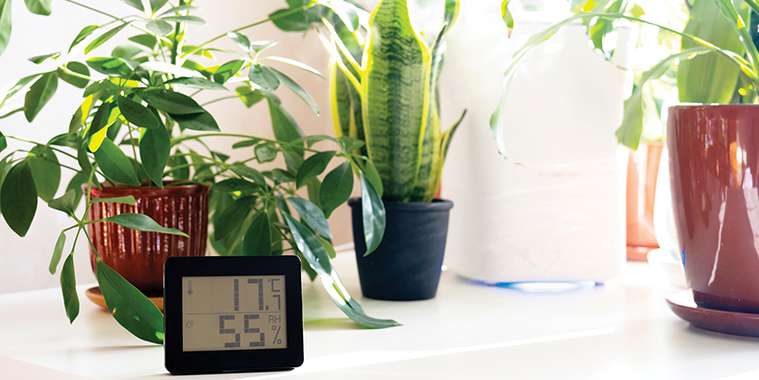The “Goldilocks zone” concept applies to many aspects of the human experience, but when it comes to finding the just-right humidity level for your home, it may not be as easy to define. Both too little and too much humidity can cause damage to your health and property.
Fortunately, the extremes are easy to notice. What isn’t as clear is where the midpoint resides. Unlike temperature, your body tolerates humidity across a wide range, somewhere between coated with sweat and bristling with static. Let’s look at how the moisture content of the air inside your home affects daily living.
The humidity scale
When we talk about humidity, we’re referring to the amount of water vapour present in the air. When it comes to the environment, we typically use it as a relative concept. The same amount of water in its gaseous form produces high humidity in cold air and low humidity in warm air. Anyone living in the Prairies knows humidity levels can be at 65% at minus 40 degrees Celsius, but when outside conditions are warmed by the furnace, evaporation empties the dog’s water bowl faster than Fido does.
Just as a towel absorbs water until it reaches saturation, so does the air inside your home. Sometimes, it’s the function of heating, ventilation, and air conditioning — your HVAC system — to control conditions inside your home. However, the priority is mostly on air temperature. Humidity sometimes gets a lack of attention.
How your system affects humidity
Generally speaking, any system that heats air also reduces humidity. However, the effects aren’t equal. Forced air furnaces are notorious for sucking moisture out of the constantly recirculating air, while hot water radiators dehumidify more gently. Similarly, electric baseboards dry air out more quickly than radiant floors, whether they’re electric or liquid. Still, in the heating seasons, adding humidity is usually the battle, regardless of your HVAC.
During the months when you seek to cool your home, removing moisture is an ancillary goal. Any form of air conditioning reduces humidity by condensing airborne water, whether it’s central air, window, ductless, or other form of air conditioning. Dehumidifier systems work in a similar way but without a widespread cooling effect.
It’s too dry!
Health Canada recommends maintaining your home’s relative humidity between 30% and 50%. Below 30% and your home is too dry and above 50%, too much moisture becomes an issue.
When humidity falls below 30% on a regular basis, you may start to notice little structural problems, things like cracks in drywall seams, warped wood, or peeling paint. If these symptoms come on top of a static zap anytime you touch something metallic, you’ve fallen below the 40% threshold.
It’s too damp!
Dry air doesn’t seem to affect your perception of temperature as much as excess humidity. Humid air in a warm room can make you feel trapped in an uncomfortable film of moisture since the perspiration layer on your skin has nowhere to evaporate.
When things cool off, high humidity causes the “cold and damp” feeling that’s no more welcome than its high temperature version. When you feel your house has a chill your body can’t shake off, watch for other signs, like condensation on windows and mirrors, wet stains on walls, or visible mould growing on surfaces. You won’t see damage like wood rot in the early stages, but count on it developing when high indoor humidity becomes chronic.
Health issues
It isn’t just the building that can suffer when the humidity stays outside the target range. Dry air can lead to nosebleeds by drying up mucous membranes, or it can trigger symptoms of dehydration like dry skin, itchy eyes, and a scratchy throat.
High humidity might also trigger asthma and allergy attacks. Moist conditions provide an environment in which bacteria, dust mites, and moulds thrive. These are all potential respiratory system irritants.
Controlling your conditions
The first step in optimizing humidity comes with understanding the conditions in your home.
Add hygrometers — which measure humidity — or thermometer/hygrometer combos to get a picture of moisture levels throughout the house. Keep in mind the environments in an upstairs bedroom and a basement utility room may be dramatically different.
How to deal with dry air:
• When your house is dry everywhere, adding a humidifier to a forced air furnace is the best systemic solution for adding moisture to the air.
• Portable humidifiers are excellent solutions for homes with just a few dry spots.
• Use your green thumb and add more houseplants — plants naturally release moisture into the air.
• Radiant heat sources won’t dry air as quickly as a furnace, so keep that in mind for renovations or spot use.
• Reduce air leakage into your house during the cold winter months by making sure your windows and doors are properly sealed.
How to deal with damp air:
• Fit your furnace with a dehumidifier or add portable units for problem spots, like musty basements.
• Use vent fans in bathrooms and kitchens to exhaust moist air.
• Reduce the number of plants in your home, or switch to arid succulents.
• Cover pans when cooking.
• Open room doors to encourage air circulation.
• In warmer months, air conditioners lower both temperature and humidity, and drier air is sometimes all you need to feel comfortable on a scorcher of a day.
Giving air moisture content the same attention as temperature may produce surprising results. Indoor humidity controlled at 45% to 55% might be the secret setting for a truly comfortable home, so consider what’s relative in your home to optimize your space.
Keep an eye out for signs of an imbalance, and if you think there are larger issues at play, reach out to an HVAC technician to get their expert advice on your next step.
— Realtor.ca



